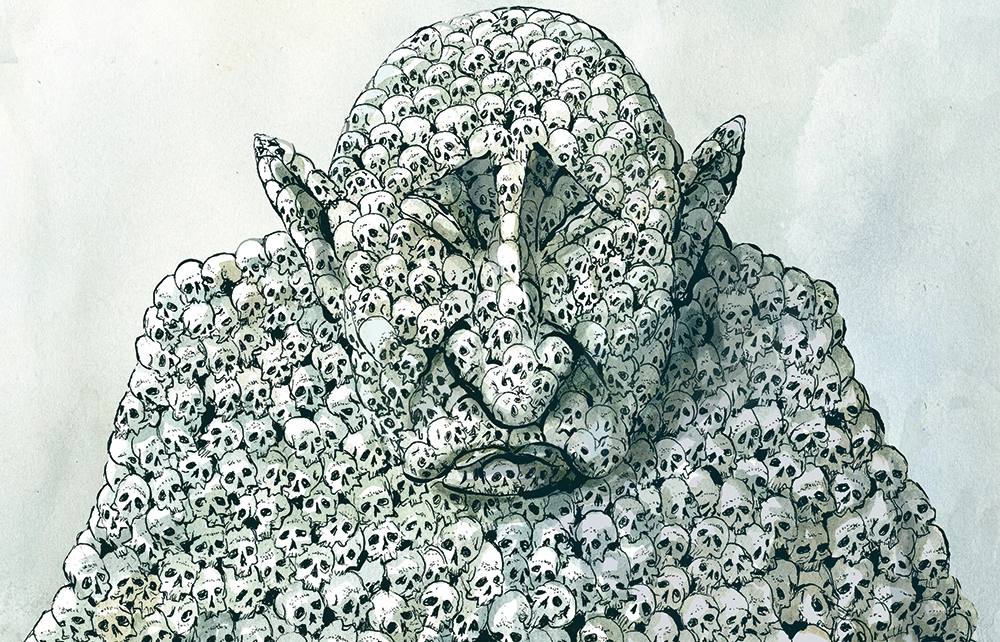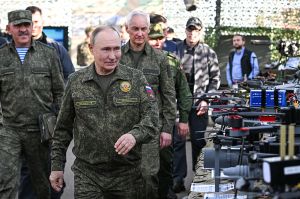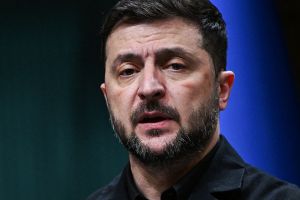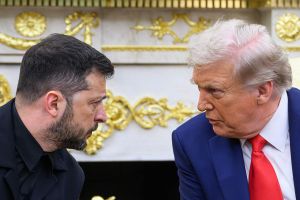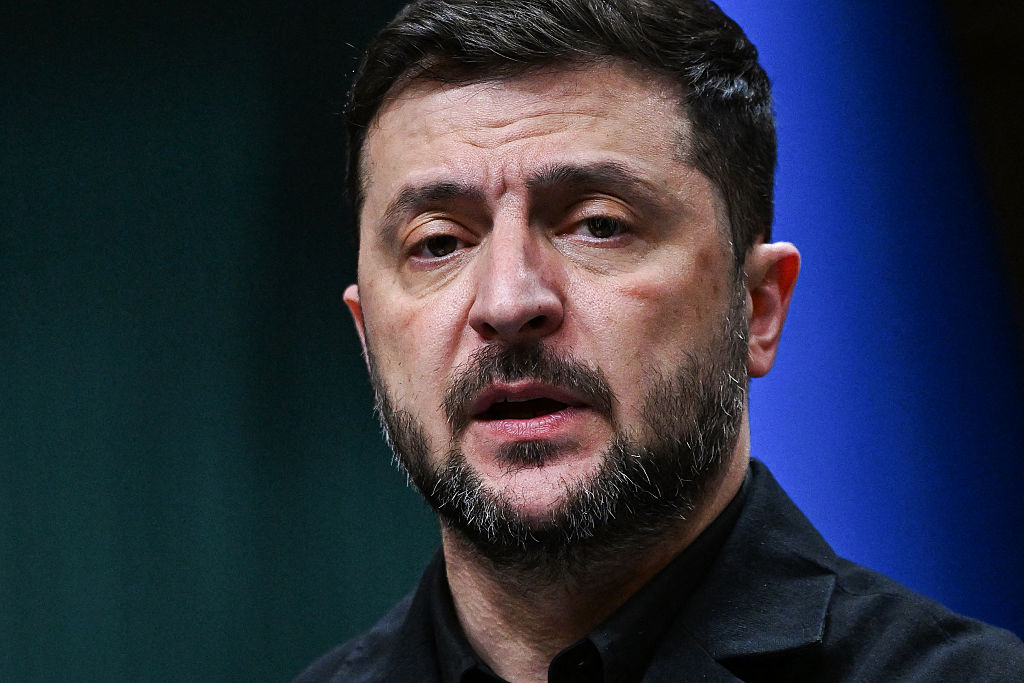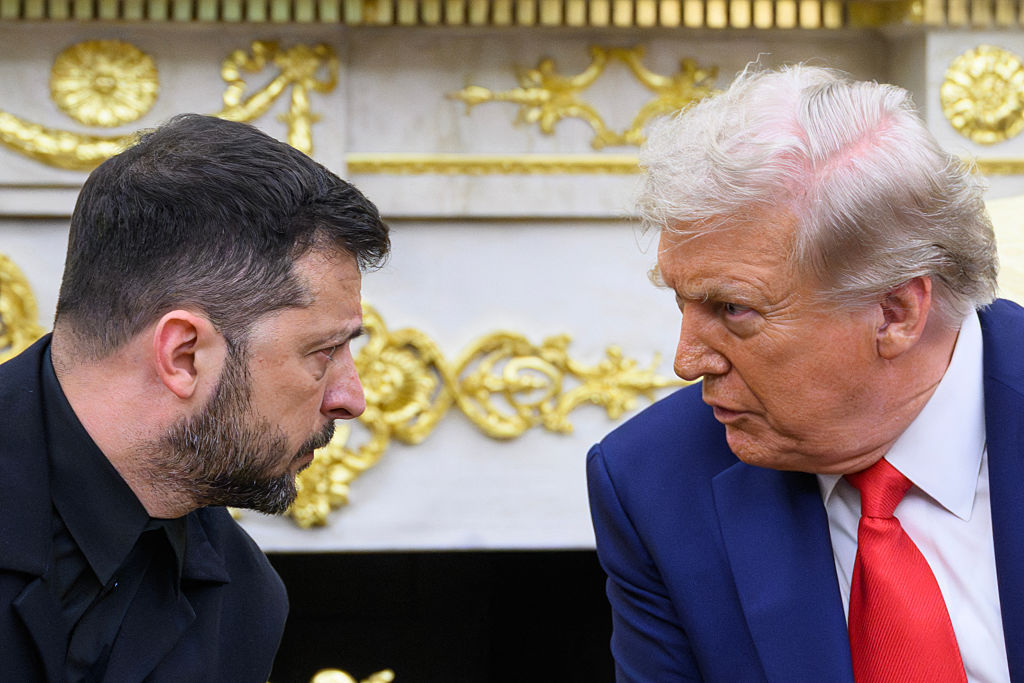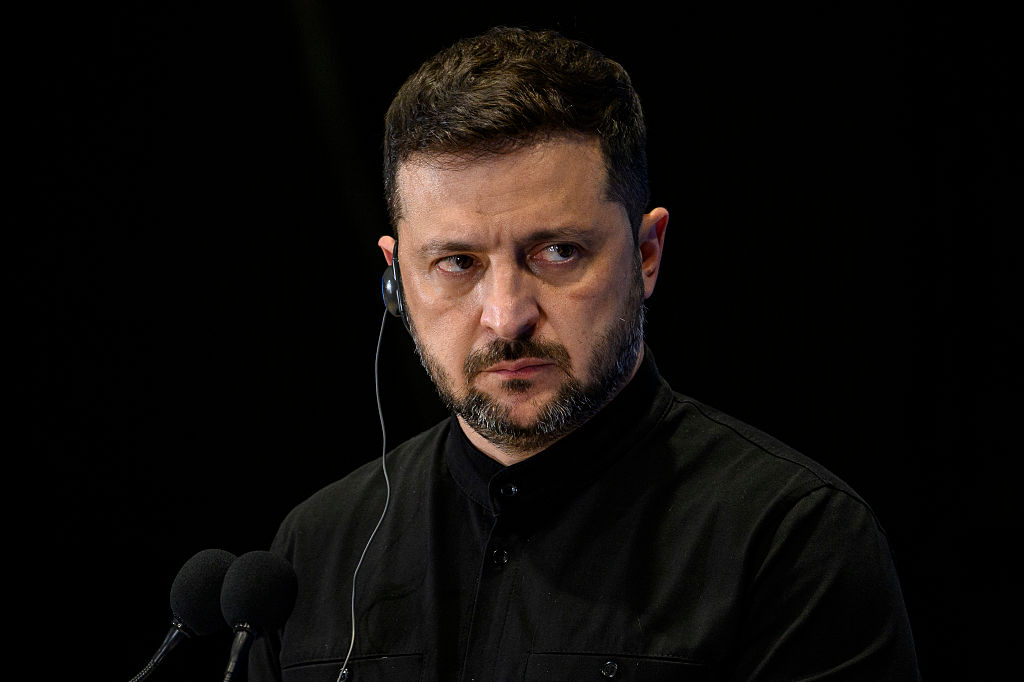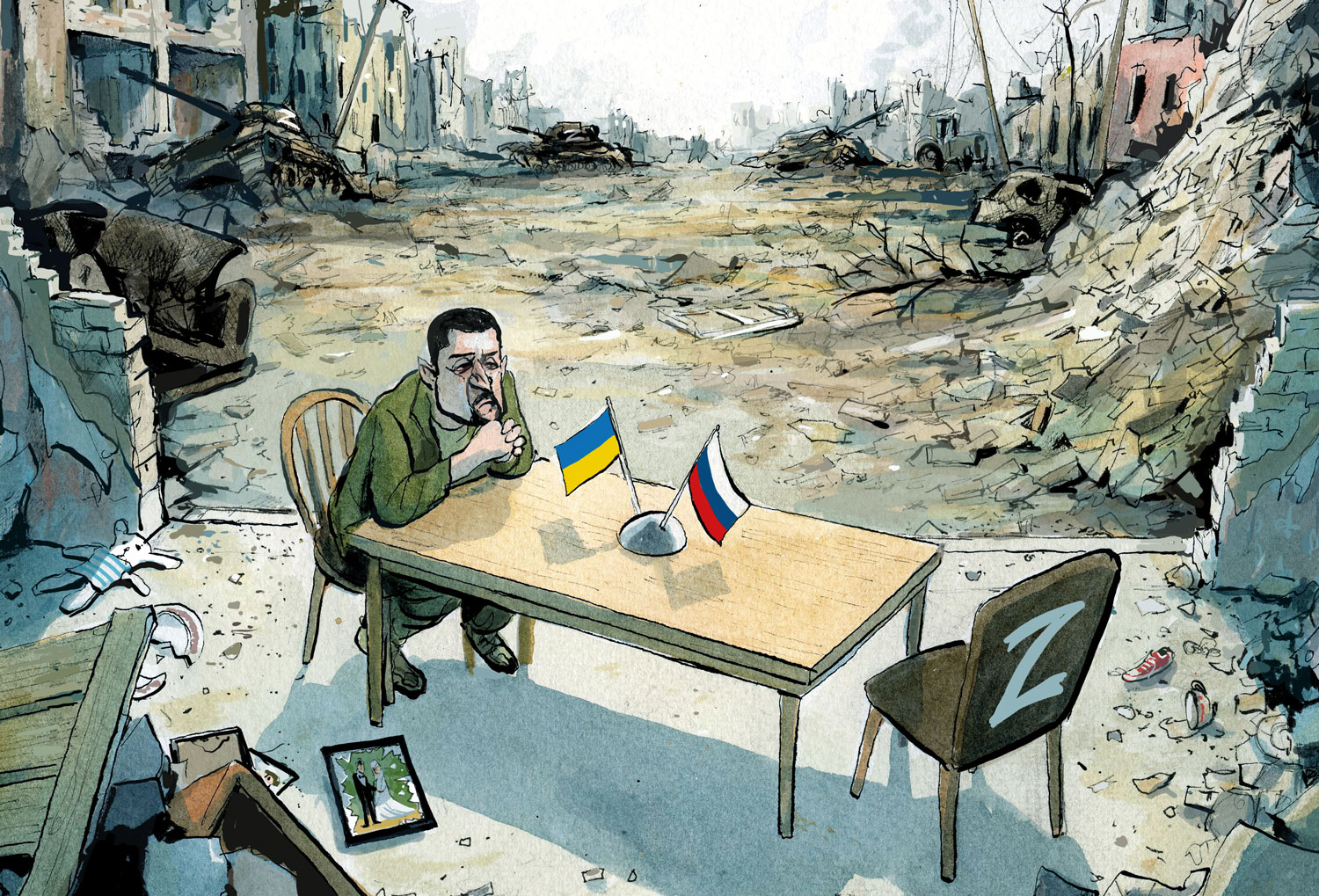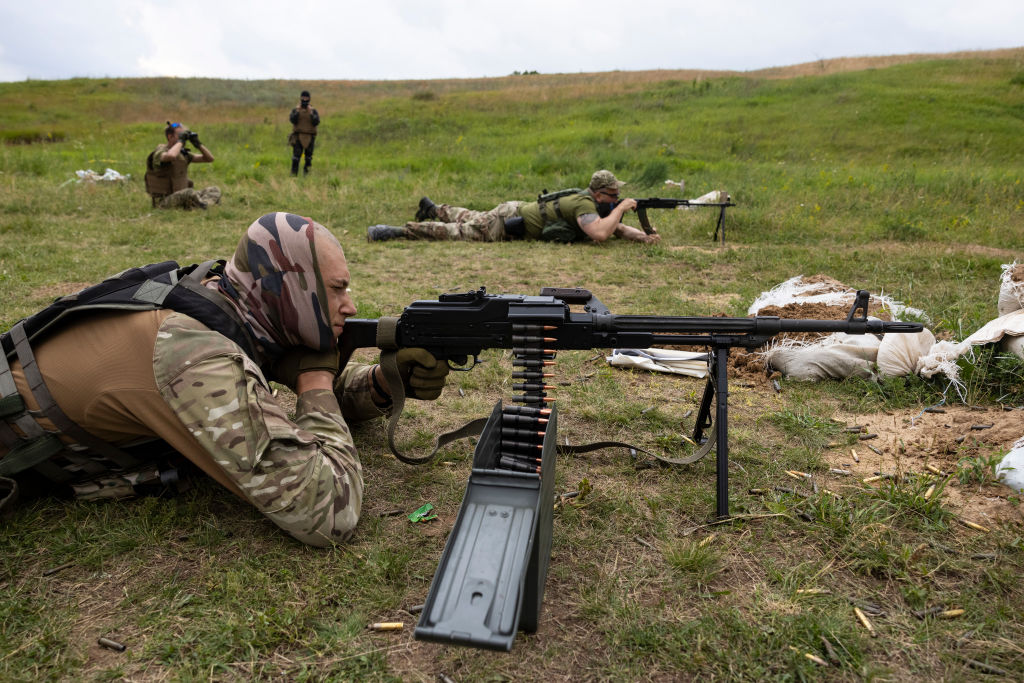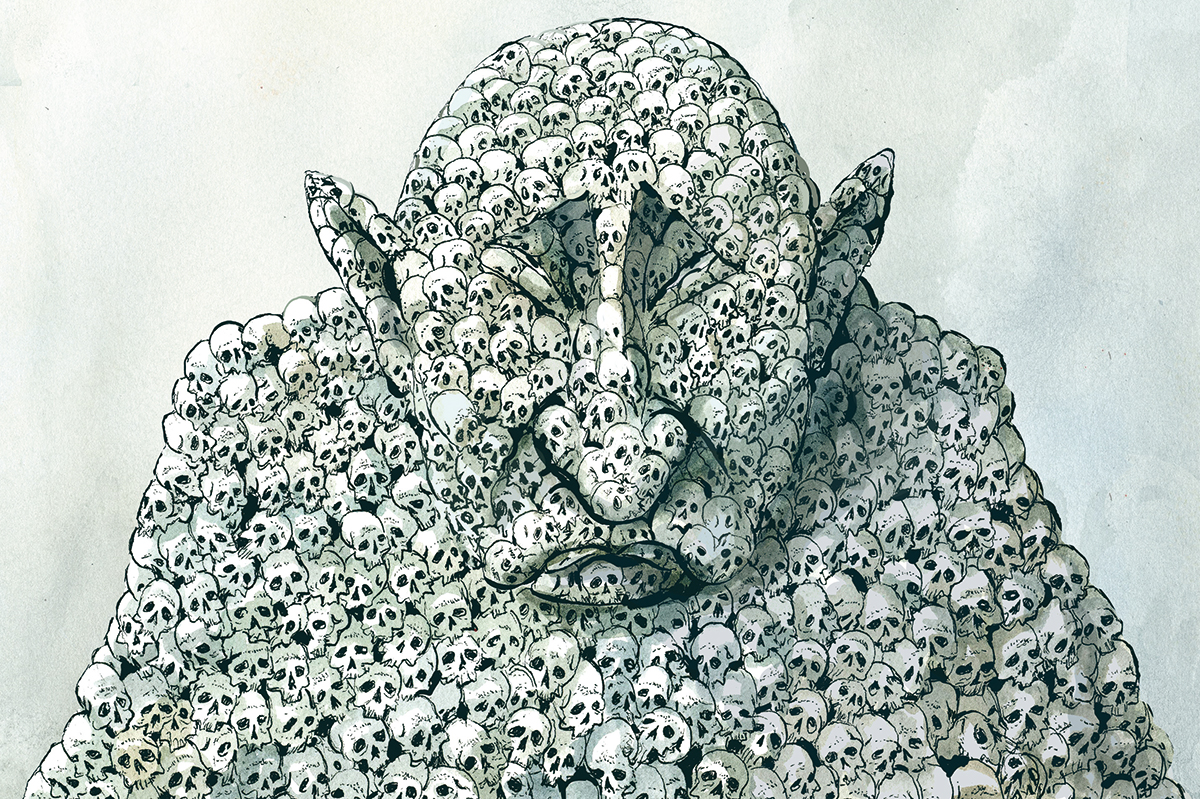Dovhenke, Ukraine
The Russian soldier lay where he had fallen. His plastic combat belt and flak jacket were still intact, but his legs were splayed at an unnatural angle, and where his face and scalp had once been there was now only a skull with dark stains on it.
Oleksiy, leader of the Black Tulip, a small team of Ukrainian men who collect bodies from the country’s eastern battlefields, gingerly tied a rope around the decaying corpse. “These bodies are sometimes booby-trapped,” he said. “We have to be careful.”
We all walked fifty or sixty yards up the muddy track we had come down and crouched. Then Oleksiy, bending low, gave the rope a tug. This time there was no explosion. Denys, twenty-one, who was wearing a baseball cap with “Donbas” written on it, picked up the skull which had detached from the body and reunited the two.
Soon the Ukrainians — six volunteers who had all been part of the same kick-boxing team before the war — had arranged the dead Russian and his equipment neatly on to a white plastic body bag. They catalogued and photographed him. He was the 299th body they had found.
The collection of soldiers’ bodies has a long history in the fields of eastern Ukraine. During World War Two, fighting in this area was intense and hundreds of dead Germans were found, the Ukrainians said, many along a line of birch trees at the edge of the field we were now in. One foxhole we passed, we were told, had originally been dug by soldiers of the Wehrmacht and then excavated again during intense fighting last summer.
Recovering the dead is an important part of any culture, but on the much-fought-over steppes on the eastern marches of Europe it has particular resonance.
A song by the Russian Aleksandr Rosenbaum about the Antonov An-12 transport planes that flew the Soviet dead out of Afghanistan — the original Black Tulip — achieved cult status in the Soviet Union and is still popular in Russia today.
Andrei, twenty-one, of the modern-day Black Tulip, said: “This job is very important — the guys who died protecting our country need to be able to go home, home to their mothers, fathers, daughters and sons.”
These days, however, for every fallen Ukrainian soldier, the team are finding on average two dead Russians. And that has added a twist to their work.
When they have photographed the Russians, they bag them and take them to a morgue where DNA samples are collected. Those samples, along with supporting evidence, are then forwarded to the Russian authorities. If the Russians accept the veracity of the submission, they are added to a list and eventually a body swap is set up. In this way hundreds of dead Russians and Ukrainians have been returned across the front lines to their own side, and eventually to their families. “Most of the time the families are happy to have them back,” Oleksiy said. “Occasionally they simply refuse to accept what has happened. If they are not claimed then the bodies are buried in unmarked graves.”
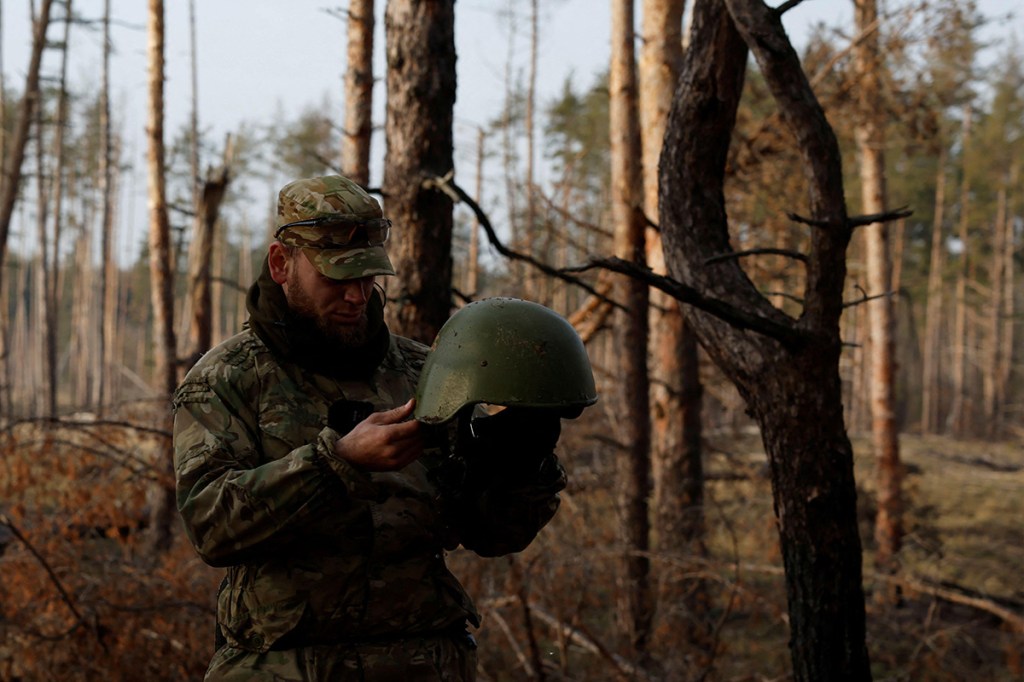
I had met up with the Black Tulip earlier that morning on a side road, a half-hour’s drive east of Slovyansk and about an hour from the current front line. The sound of shelling was still just audible in the background. I was traveling with a Canadian journalist, a friend with whom I had worked in Moscow in the early 2000s. We drove through the tiny shattered village of Dovhenke. It had been on the front line for much of last year and every house was damaged, mostly beyond repair.
At the end of a muddy lane, we parked up and began a long walk through an open field in single file. Mines were scattered on both sides of the narrow path and we did our best to warn each other when we spotted them, but the Ukrainians were moving quickly. Some were green anti-tank mines — about the size of a dinner plate and the depth of a hefty book. But there were also plastic butterfly mines, designed to wound or maim soldiers on foot, known as “petals” in Russian.
Eventually we came to a place where military debris was scattered around — old food packs, medical supplies, a discarded water bottle and a camouflage flak jacket.
On our left was a tank that had been blown up. It appeared to be a Soviet-made T-72. Its tracks had come off and it had burned. Oleksiy approached it carefully, using a long metal prod to test the ground for mines.
A few hundreds yards further on we found the dead Russian soldier with his legs splayed. Judging by his uniform he had been a member of Rosgvardia, a paramilitary force put together by Vladimir Putin to crush dissent at home, but whose rank and file had been drafted to bolster the Kremlin’s military effort in Ukraine.
The Ukrainians checked the dead man’s pockets. They found a lighter with the inscription “My heart wants romance, but my ass wants adventure.” “Well, he certainly found that,” one of them muttered.
The men were careful with the body, almost delicate. But when we asked Vasily, fifty-five, how he felt about the dead Russian, his face hardened. “He is a stain and we need to remove him from our land,” he said.
The second body we found that day was in an armored personnel carrier (APC) partially hidden in a line of trees, about a mile from the first. The APC had been incinerated, burned so hot that even some of the metal had deformed. Oleksiy crawled inside and began to root around in the place the driver would have sat.
“Is there anyone in there?” I asked.
Oleksiy explained how he had learned to distinguish between different body parts even when they have been burned to a crisp. “If you are looking for a body that has burned inside armor you have to use your imagination,” he said. “You have to imagine how a body will burn.”
An hour later, Oleksiy had collected a metal tray of charred remains. He added the blade of a knife — the plastic handle had melted away — and a few deformed parts of the soldier’s flak jacket. I noticed a small piece of jawbone.
At first the team were unsure if they were looking at a Ukrainian or a Russian corpse. The model of APC was in use by both ex-Soviet armies. But finally they found an obscured serial number and then a Russian-made boot. As Oleksiy prodded around inside the APC, I spoke again to Denys, the twenty-one-year-old with the baseball cap, who was perched on top. I asked him how he felt about his job. “Everybody has a role to play in this war,” he said. “This is mine. We’ll be doing this for years to come, there is so much work left to do.”
In fifteen years covering wars, I have seen hundreds of dead bodies. Corpses, especially as they decay, have a pungent, almost sweet smell and I was always grateful when it had been cold outside. With the temperature hovering around zero, the body of the first Russian we had found had smelled only faintly.
“Is it not worse in the summer?” I asked Denys. “The smell…”
“Ah, you get used to it,” he replied casually. “Worse is when we get shot at.”
By the time we had finished documenting the second body it was early afternoon. The Black Tulip had a third body to collect, but it was several miles away and they were going on foot. My Canadian friend and I decided to walk back in the direction we had come. I led the way through the field, straining to keep my eyes sharp and struggling to remember the location of the mines we had seen. An hour later we were back at the vehicle. That night we were far away and in relative safety.
A week later, the Black Tulip took time off work, a rare event. They gathered for a funeral in nearby Slovyansk. As a van arrived and a coffin was carried out and prepared for burial, Lyudmila Sosnenko cried out in anguish: “Why? My son…”
In the coffin was Denys, the twenty-one-year-old Black Tulip with the Donbas baseball cap. A few days after we had parted he had been killed when his van hit an anti-tank mine.
This article was originally published in The Spectator’s UK magazine. Subscribe to the World edition here.



